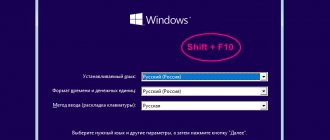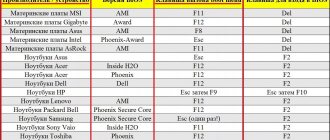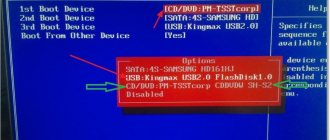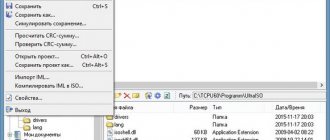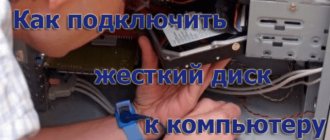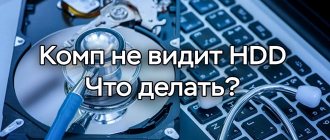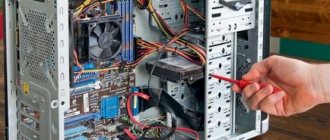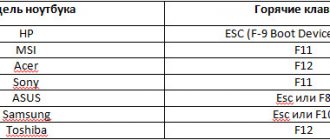In what situation might you need to clean the hard drive through BIOS? In most cases, this becomes necessary when errors occur during reinstallation of the operating system, or less often when the computer is infected with serious viruses. In this article, you will learn about all the possible ways to format a hard drive through the BIOS, including using the command line and the OS installer.
If the operating system does not start or does not work correctly, you can always completely clean the hard drive to roll a new OS onto it. How to do this through BIOS? No way. Not a single modern BIOS is equipped with tools for formatting a drive. In this process, it acts only as a connecting link, an intermediary between formatting software and the hard drive itself, since it has access to it by default.
Before you begin, it is worth noting that formatting your hard drive will delete ALL information on it. Therefore, if your storage contains files that are valuable to you, transfer them to another medium or format only the problematic local drive, and not the entire hard drive.
To carry out the process you will need a special software tool. This could be the standard operating system installer or an application that comes with it on disk, such as a Live CD. You can also use the regular command line.
Control via BIOS
Formatting a disk using BIOS
27.03.2017
Owners of personal computers or laptops may sooner or later encounter such a problem when they urgently need to format their hard drive. The reason for this may be various factors, but the point is that in some cases formatting from an operating system, for example, Windows 7, is impossible. In this case, there is an option to format via BIOS.
Command line
There is a way to clean Windows without starting the installation, but using the command line. To do this you should:
- Reach the stage of loading data from the installation flash drive according to the instructions from the first method.
- Click “System Restore”, then follow the path “Recovery” - “Diagnostics” - “Advanced” - “Command Line”.
- In the running command prompt window, enter the command that matches your task. After entering the command, click on the Enter key. After the completed operation, you will receive a fully formatted hard drive.
Teams:
- Full formatting FAT32 – format /FS:FAT32 C: /u
- Full formatting to NTFS format – format /FS: NTFS C: /u
Under the letter C: is the hard drive partition. If you don’t know what name your disk is recorded under in an ASUS or HP laptop, you can see this using the sequentially entered commands Diskpart and list disk . To achieve quick formatting, replace the “/u” operator with “/q”.
BIOS entry options
So, having a bootable media with the operating system recorded on it, you first need to insert it into the USB port on your computer. After this you need to enter the BIOS. Unfortunately, there is no universal solution for this, and depending on the computer manufacturer, the login method is different, but now two ways will be presented on how you can get into it.
Method 1: Knowing the computer manufacturer
If you know which company made your computer, you can easily find out the key to enter the BIOS. To do this, use the hint below. Just look for the name of the manufacturer in the left column, and find out the same key in the right column. By the way, you need to press it when the PC starts, when the initial screen appears.
Method 2: Start screen prompt
If you still couldn’t find the right key using the table above, or you simply don’t know the name of the company that produced your device, then there is another option, although it does not work on all BIOS versions.
Its essence lies in the fact that when you start the computer, at the moment the initial screen appears, the very name of the key that serves as a guide to the BIOS is displayed on it.
But at this stage, difficulties may arise, because, as you know, the loading time of this screen is quite fast, and not everyone will have time to find the hint among the mass of text, especially since its location is different on each computer. Here you can use a trick that few people know about. If you press the Pause key on the keyboard during loading, it will stop, thereby giving time to detect the treasured inscription. You can see the location of the Pause button in the image below.
Via Windows Installer
A popular way to format a hard drive through BIOS is to use bootable media or a flash drive with Windows 10 installation files (or versions earlier). At the installation stage, there is a point where you need to prepare the hard drive for recording by first wiping it. It is this cleaning tool that can be used to clean your hard drive.
To get to this point, you need to do two things: create installation media and boot from this media. On a laptop or any other PC with the OS installed, do the following:
- Go to the page and click “Download Tool Now”.
- Run the utility and agree to the user agreement.
- Begin the download and installation by clicking “Create installation media.”
- Select Windows options (it doesn’t matter which ones) and pull up the connected DVD or flash drive.
- Then wait until the installation process is completed.
- Install a boot disk/flash drive into the computer whose HDD needs to be cleaned.
- Start the PC and press the Delete key (on laptops one of F1 - F12) to enter the BIOS (UEFI). But the easiest way is to go to the BOOT Menu - see the key in the table below. Next, we expose our flash drive for loading. If this does not help or you cannot find the desired key, then go to the BIOS.
- Set the boot priority from the disk where the installation files are located. To do this, go to “Advanced Mode” – “Download” – “Boot option #1” – “flash drive”.
- Save the changes and restart the PC.
- If everything is done correctly, it will start loading from the Windows installation media.
- Click Next, then Install.
- At the initial stage, skip “Activation” by clicking “I don’t have a key.”
- Select any system and click “Next”. There is no need to install it.
- Agree with the license agreement.
- Click "Custom".
- Then select the desired disk and click “Format” on it. Agree to the deletion of all data.
- If the disk has not been used before, and your task is to prepare it for use under the Windows system, then to add the necessary markup to it, click “Create”.
- Select the entire available size to create one logical partition. If you divide, a pair of logical drives will be created.
- Click apply and confirm creation.
- You can finish at this stage. Restart your PC and go into the BIOS again to return the priority to the same as before (if necessary).
In this way, using a Windows disk, we managed to clean the drive and can use it in a new way.
Description of the procedure
To perform this, you will need a boot device with a recorded OS (it is advisable to create it in advance). The sequence of steps to format a disk via BIOS is as follows:
- Restart the computer with the connected media and immediately after startup enter the I/O system using the appropriate key. Usually this is F12, F8 or Escape, but if the version is very outdated, other combinations may be used.
- In the window that appears, you need to open the Boot tab, then Boot Option Priorities. This section allows you to select where the OS will be loaded from (from a flash drive or other device), which is what you need to do. Depending on the removable media, mark the USB port or CD-ROM.
- Exit, saving your changes, after which the computer will restart. Before you start formatting the disk, you will need to launch the OS from the selected device by pressing any key on the laptop.
- Call the command line. If the procedure is carried out using Windows 7 media, press the combination Shift+F10. For version 8, this method does not work; it is replaced by the user interface.
- Make sure the drive letter is correct before formatting the drive. After starting from the boot device, it may change, so to avoid deleting important files, you need to enter “wmic logicaldisk get device >
Then all that remains is to wait for the end of the process, confirming the command by pressing Enter.
We use the Acronis Disk Director Suite program
This program is usually included in the LiveCD and other Windows OS builds, and is an auxiliary utility for working with the hard drive. After launching the application, select the hard drive you need to format, right-click on it, in the menu that appears, click on “Format”, select the type of file system and confirm the operation by clicking “Run”. After the operation is completed, reboot.
You can visually see how this program works in the video:
Video on the topic
According to available statistics, several hundred people every day are interested in the answer to the question of how to format a hard drive via BIOS. I note that the question is not entirely correct - in fact, formatting using BIOS alone (at least on regular PCs and laptops) is not provided, but, nevertheless, I think you will find the answer here.
In fact, when asking a similar question, the user is usually interested in the ability to format a disk (for example, drive C) without loading Windows or another operating system - since “from within the OS” the disk is not formatted with a message that this volume cannot be formatted. Therefore, we will talk about formatting without loading the OS - this is quite possible; By the way, you will also have to go into the BIOS along the way.
FAT32 or NTFS
If you need to format the disk, you can select one of the file systems. By the way, the need to change it is also the reason for formatting the disk. It doesn't matter which system was installed before, all programs and versions of Windows work with both options. Let's figure out what to choose.
NTFS supports working with large amounts of data, but experience shows that it is slower on older machines with low performance. This is her only drawback. If you choose FAT32 , then you need to take into account that copying or moving a file larger than 4 GB will not work, because when the system was developed, all computer memory was smaller. Also, this system does not support data encryption and restriction of access to it. Therefore, if speed is important with limited hardware capabilities, then you should choose FAT32 , otherwise NTFS , which is more suitable for hard drives of modern machines.
Question answer
Bios does not see the Samsung hard drive; when you turn on the computer, it makes one short beep and that’s it. When connecting a second working hard drive at the same time as this Samsung drive, the computer freezes.
Answer . It is possible that the bios does not detect the hard drive because it has failed (this could be mechanical or electronic). If there is a speaker attached to your PC's motherboard, it may produce a sound that can diagnose an HDD problem.
If possible, check the visibility of the hard drive on another computer, but the symptoms indicate that this is still a failure.
What is formatting and how does it help?
The design of the hard drive is extremely simple. The main disk of a computer is a round plate with a magnetic coating applied to it. Its surface is absolutely smooth and polished to a mirror shine. There are no sector markings on it, and where this or that type of information will be stored is determined by the formatting operation. During this process, the plate is physically marked and any broken or damaged areas are inspected. Such places are excluded as unreliable and information is not recorded on them. Primary disk formatting is performed at the manufacturing plant. All subsequent cases occur every time you reinstall Windows. Each of them checks the disk surface to avoid a conflict between the system and newly recorded programs.
Attention! Formatting will lead to complete loss of data previously saved on the laptop. For example, only an experienced programmer can restore your favorite photos using special utilities. For money, of course.
